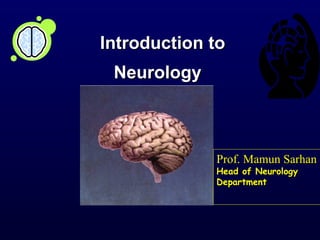
Introduction to neurology
- 1. Introduction to Neurology Prof. Mamun Sarhan Head of Neurology Department
- 2. WHAT IS NEUROLOGY? Neurology is the branch of medicine that deals with diseases of the nervous system.
- 3. Major divisions Central nervous system Nervous System Peripheral nervous system
- 4. Intracranial Intracranial Spinal Spinal part part part part 1.Cerebrum Spinal cord & 2. Brain stem Cauda equina 3. Cerebellum
- 5. Cerebrum Two cerebral hemispheres Connected to: 1. each other by corpus callosum 2. brain stem by cerebral peduncles
- 6. EACH CEREBRAL HEMISPHEREDEVIDED INTO : four lobes: 1. Frontal 2. Parietal 3. Temporal 4. Occipital
- 8. Brain stem Formed of : Midbrain Pons Medulla Connected to: 1. Cerebral hemisphere by cerebral peduncles 2. Cerbellum by cerebellar peduncles
- 9. Contains: • CN 3,4 in midbrain • CN 5,6,7,8 in pons • CN 9,10,11,12 in medulla
- 10. Names of cranial nerves • Ⅰ Olfactory nerve • Ⅱ Optic nerve • Ⅲ Oculomotor nerve • Ⅳ Trochlear nerve • Ⅴ Trigeminal nerve • Ⅵ Abducent nerve • Ⅶ Facial nerve • Ⅷ Vestibulocochlear nerve • Ⅸ Glossopharyngeal nerve • Ⅹ Vagus nerve • Ⅺ Accessory nerve • Ⅻ Hypoglossal nerve
- 11. Classification of cranial nerves • Sensory cranial nerves: contain only afferent (sensory) fibers – ⅠOlfactory nerve – ⅡOptic nerve – Ⅷ Vestibulocochlear nerve • Motor cranial nerves: contain only efferent (motor) fibers – Ⅲ Oculomotor nerve – Ⅳ Trochlear nerve – ⅥAbducent nerve – Ⅺ Accessory nerv – Ⅻ Hypoglossal nerve • Mixed nerves: contain both sensory and motor fibers--- – ⅤTrigeminal nerve, – Ⅶ Facial nerve, – ⅨGlossopharyngeal nerve – ⅩVagus nerve
- 12. Sensory cranial nerves N. Name Function Assessment Ⅰ Olfactory Smell Examination of smell Ⅱ optic Vision Acuity, field & fundus Ⅷ Vestibular Equilibrim Caloric and part rotational chair Cochlear Hearing Watch test, part weber test
- 13. Motor cranial nerves N. Name Function Assessment Ⅲ Oculomotor Motor to superior, inferior and Ptosis, pupil, eye medial recti; inferior oblique & movements & levator palpebrae superioris squint Parasympathetic to sphincter papillae and ciliary muscle Ⅳ Trochlear Motor to superior oblique Look to opposite shoulder Ⅵ Abducent Motor to lateral rectus Lateral eye movement Ⅺ Accessory Motor to sternocleidomastoid Elevaton of and trapezius shoulders and neck rotation Ⅻ Hypoglossal Motor to muscles of tongue Tongue movements
- 14. Mixed cranial nerves N. Name Function Assessment V Trigeminal Muscles of Face sensations & mastication & power of muscles of sensations of face mastication VII Facial Muscles of facial Muscles of facial expression & taste expression & taste sensation in ant. 1/3 sensation in ant. 1/3 of of tongue tongue X Vagus Sensation and Palatal and pharyngeal movements of reflexes & movements of Larynx, pharynx, uvula thoracic and abdominal organs XII Glossopharyng- Taste in post 2/3 of Taste & general eal tongue & gen. sensation and sensation pharyngeal reflex
- 15. Cerebellum • Behind the brain stem • Formed of : medline vermis two cerebellar hemispheres • Composed of : outer grey matter and inner White matter
- 16. Cerebellar peduncles MB Pons C MO Superior peduncle connects cerebellum with midbrain. Middle peduncle connects cerebellum with pons. Inferior peduncle connects cerebellum with medulla oblongata
- 17. Hemispheres and vermis left right hemisphere hemisphere vermis Cerebellar hemispheres are the two bilateral structures. Vermis is the unpaired midline structure between the two hemispheres.
- 18. Spinal cord • Inside spinal canal • End at lower border of L1 • The lowest 3 segments = Conus • The above 4 segments = Epiconus • Inner grey matter and outer white matter
- 19. Cauda equina • Lumbosacral roots collection fills the lower part of the spinal canal bellow L1
- 20. Cauda equina Brachial plexus Lumbosacral plexus Cervical enlargement Lumbosacral enlargement
- 22. Peripheral nervous system • A.H.Cs • Roots • Plexuses • Peripheral nerves
- 23. mo to r Upper co motor rte x neuron internal capsule Medulla anterior horn cell Lower motor neuron
- 24. Motor pathway
- 25. UMNL LMNL Tone Increased, with Decreased ‘clasp knife’ quality Clonus Present Absent Fasciculations Absent Present Muscle Wasting Absent, but disuse Present (within 2-3 atrophy eventually weeks) results Tendon Reflexes Increased. Extensor Decreased or plantar reflexes. absent. Flexor plantar reflexes. Distribution Whole limbs, with Specific muscle more weakness in groups affected (e.g. the upper limb in the distribution of extensors and lower a spinal segment, or limb flexors just the proximal muscles, etc.)
- 26. Thank You!!!
